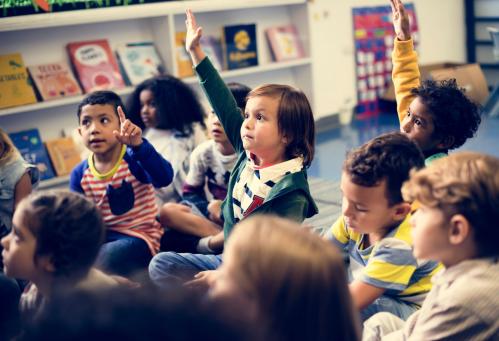Editor’s Note: Pakistan’s humanitarian crisis brings a sharp focus on the need for long-term socio-economic development in the Northern region. In the Conflict Resolution and Prevention Forum, Rebecca Winthrop addressed the humanitarian crisis in Pakistan and called for further innovation and investment of education for girls and women.
Thank you for having me here today. The description of this event [titled “Crisis and Opportunity: A 3D approach to humanitarian aid in Pakistan] highlights the need to discuss long-term solutions to the current humanitarian crisis in Pakistan. It also references the possibility of having opportunities in the midst of crisis. With that in mind, I would like to present one main argument to all of you. Despite the dire humanitarian needs of the displaced and host communities in Northern Pakistan, there are real opportunities to improve their long-term socioeconomic status by finding innovative ways to educate girls and women.
Benefits of educating girls and women:
Educating girls and women is one of the most leveraged investments there is. Not only does it bring a range of benefits to the individual girls and women—such as, self-confidence, ability to make informed decisions, critical analysis of propaganda, which is crucial in the battle against the Taliban—it also has a large ripple effect. Educating girls and women improves the health status of children and the economic development of their communities. Every 1 percent increase in women’s education generates a .3 percent increase in economic growth. Exclusion from the socioeconomic development of the country is one of the root causes of the conflict in Northern Pakistan. The government of Pakistan invests $11 per capita on development efforts in Federally Administered Tribal Areas (FATA) and $25 per capita in the rest of the country. The educational attainment of girls and women in the north is markedly lower than in other areas. The current humanitarian crisis and displacement could provide a window of opportunity for girls and women, many of whom have never before had access to education, to learn critical skills.
The impact of conflict on education:
The education system has been profoundly affected by the crisis. However, prior to the conflict, the system struggled to reach girls and women. The women’s literacy rate in FATA is only 3 percent and in the North-West Frontier Province, (NWFP) it is 18 percent. This is much lower, especially in FATA, than the national level women’s literacy rate of 32 percent. The male literacy rate is much higher: 30 percent in FATA, and 50 percent and 54 percent in NWFP and national level, respectively. On top of this, the humanitarian crisis has disrupted learning and on a massive scale. The U.N. estimates that 1.2 million children in the region hosting internally displaced people are in need of education services.
To understand how the crisis has affected education for children and young people, it is important to look at two distinct but related arenas:(1) the areas of conflict and the people who fled the conflict, and (2) the communities receiving and hosting the internally displaced people. In the first area, educational infrastructure has been destroyed, approximately 280 schools—70 percent of which were girls schools—were destroyed in Swat alone. Fleeing their homes and communities has meant that over 560,000 displaced children and young people are in need of education. Most of these young people are residing with their families in host communities, staying with relatives or friends, and those without these connections, approximately 15 percent, are staying in spontaneous settlements and camps. Currently, children ages 5-11 who reside in camps have the most access to education, and youth ages 12-17 who reside in host communities have the least access to education. Fifty-four percent of children in camps are accessing education while only 3 percent in host communities and 8 percent of youth in camps are accessing education while virtually none are in host communities. Indeed, the vast majority of displaced girls and boys are not accessing education at all.
In the second arena, host communities, children and youth have also had their education disrupted. Currently almost 4,000 schools are being used as shelter for the internally displaced. The government assigned schools and colleges to be centers for registration and relief in order to accommodate the massive influx of people. This has meant that education has been disrupted for over 700,000 children and youth. Children, who are currently on summer break, left school one month early and it is very unlikely that they will be able to return to school on September 1when the school year begins. In addition to finding new locations for the people living in the schools (whether that be returning home or in another area of the host community), there are a number of repairs that would need to made to the school structures before students could return.
National and international humanitarian response:
The government is leading the humanitarian response, including in education. U.N. agencies, such as UNICEF and UNESCO, along with international civil society organizations, such as Muslim Aid, the International Rescue Committee, and CARE International, and many energetic local NGOs, are all complementing the government efforts in educational provision. The focus has been on providing primary and secondary education to displaced and host community children and youth, along with non-formal education for those who have never been to school, especially girls. A number of creative strategies are being employed to achieve this, such as adding a second shift of classes during the afternoon, providing teachers with a rapid three-day training on how to support students whose lives have been so disrupted, and ensuring critical life-saving messages are taught such as how to identify and avoid landmines, an important survival skill for children when they return. There has even been the development of a “minimum education package” that should be part of any primary or secondary education support, which includes:
- safe learning facilities with gender appropriate water and sanitation facilities;
- recreation and psychosocial support materials, including for very young children;
- teaching and learning supplies;
- hiring teachers with minimum qualifications and ensuring a three-day prep training;
- financial compensation for school support staff; and,
- community engagement.
Moving forward—identifying and resourcing innovations for girls’ education:
While these strategies are all important, there is a special need to focus concerted efforts on reaching girls and young women. By all accounts, it has been quite difficult, to date, to reach this population with education services. But, we know from lessons learned from other humanitarian crises that displacement can often open up a window of opportunity for girls and women due to shifting and disrupted social structures, challenges to government systems, and new organizations working in communities. From Darfur to Afghanistan, conflict and crises has exacted a terrible toll on populations but has also seen progress in girls’ education. In Darfur, there were more girls enrolled in school last year than before the crisis began. In Afghanistan, home-based schooling for girls has now grown into a government accepted strategy for educating girls in remote areas. What started as a clandestine innovation during Taliban rule has now grown into one of the main approaches for ensuring girls access to school.
To support long-term socioeconomic development, we should all be thinking now about what innovative education approaches for girls and women can be tried and tested in this crisis and then incorporated into educational reconstruction when the displaced people return to their homes in the future. However, this goal can only be realized with substantially more funding given to the humanitarian crisis, which needs over $300 million. Within this, the education sector is only 17 percent funded, one of the sectors in greatest need of donor countries to support it.


Commentary
Crisis in Pakistan: Educate Women and Girls for Long-term Solutions
July 14, 2009